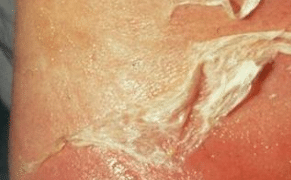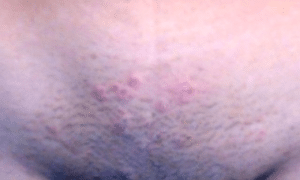White Spots
White Spots on Tonsils, Patches, Swollen, Stuff, Infection, STD, Pus, Throat, Causes, Symptoms, Treatment
on
What are the white spots on my throat? Is it tonsils infection? Get more insights on the causes of white spots on tonsils, swollen white stuff patches that looks like STD, treatment and how to prevent.
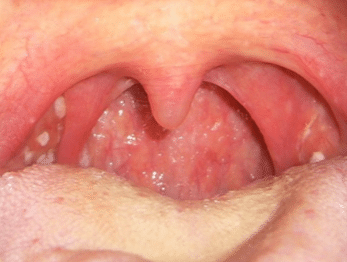
white spots on tonsils
White patches on tonsils can cause worry especially when they are painful and filled with pus. This is a sign of an infection and may associate other symptoms such as painful swallowing, pain at the roof of the mouth, throat discomfort and even bad breath.
There are various treatments of these swollen white stuff in your throat depending on the causes. The best cure has to begin with diagnosis to establish the causes and hence a good medication or treatment.
White Spots on Tonsils – Causes, Symptoms and Treatment
A number of conditions appear to be the reason for white spots to appear on the throat. Here are common causes and symptoms:
Tonsil Stones
Tonsils are part of lymphatic system that helps combat infections. The two masses of tissues filters and traps germs that are likely to enter the respiratory system to causes an infection. They produce antibodies to fight foreign objects but sometimes they also get infected.
When crevices of the tonsils get hardened and showing white deposit of stuff is regarded as tonsil stones. These patches and fragments are mainly caused by food particles stuck with mucus and dead cells which eventually attract bacteria.
Tonsils always have a self-defense mechanism cells that fights against most infection such as microbes. Continuous deposit of food particles and dead cells that eventually solidifies eventually attracts microbes.
Symptoms of tonsil stones
Mainly tonsil stones are characterized by the following symptoms:
- Bad breath.
- Sore throat
- Pain while swallowing.
- Pain at the roof of the mouth.
- Fever and lack of appetite.
How to treat tonsil stones
In most cases tonsils are harmless, they hardly cause breathing problems. They can cause a discomfort in the throat and that is why most people think of getting them removed, although it is not advisable to do that. Treatments ranges from home remedies to serious medical procedures as follows:
- Gargling with salt water can help dislodge tonsil stones and ease the discomfort and any pain in the throat.
- Coughing with high intensity can also help in easing out the condition.
- Manual removal of white spots on tonsils using a cotton swab and gently with clean fingers can help. Can be done on own or by the help of a doctor.
- Coblation cryptolysis in a treatment that involves the use of radio wave to transform a salt solution charged ions that are made to cut through tissues.
- Surgical removal using scalpel or laser can be used for chronic and severe cases of tonsil stones.
Tonsillitis
This is the inflammation and swelling of tonsils mainly caused by bacterial and viral infections. This condition is common in children and may happen frequently. In children symptoms such as nausea, vomiting and abdominal pain are common.
Streptococcus is a bacterial that causes this condition. Other common causes include, Adenoviruses, Influenza virus, Epstein-Barr virus, Parainfluenza viruses, Enteroviruses, Herpes simplex virus among others.
Symptoms of Tonsillitis in adults
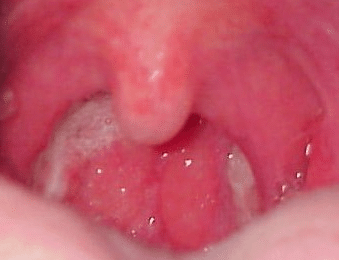
white dots on tonsils
- Throat pain or tenderness.
- Redness of the tonsils.
- A white or yellow coating on the tonsils.
- Painful blisters or ulcers on the throat.
- Hoarseness or loss of voice.
- Loss of appetite.
- White spots on throat.
- Earache or pain.
- Difficulty swallowing or breathing through the mouth.
- Swollen glands in the neck or jaw area.
- Fever, chills.
- Bad breath.
Treatment for Tonsillitis – How to Cure
The doctor need to determine the main causes of this condition before giving a treatment. Rapid strep test or throat swab should be conducted to determine the presence of bacterial or viral infection. Antibiotic are will however be given if the test is positive. The patient ought to take medication as prescribed to avoid reinfection.
Tonsillitis caused by viral infection treatment does not respond to antibiotics. For that case, the body should be given a conducive environment to fight on its own. While that is taking place here are some of the ways you can help in boosting your immune system:
- Get enough rest
- Drink warm or very cold fluids to ease throat pain
- Eat smooth foods, such as flavored gelatins, ice cream, or applesauce
- Use a cool-mist vaporizer or humidifier in your room
- Gargle with warm salt water
- Suck on lozenges containing benzocaine or other anesthetics
- Take over-the-counter pain relievers such as acetaminophen or ibuprofen.
Tonsillectomy Surgery
This type of treatment involves complete removal of tonsils through a surgical procedure. Alternatively other techniques such as radio waves, laser, ultrasonic energy or electro cautery may be used to evaporate away the swollen tonsils. Tonsils are very important tissues in the body and they highly contribute to the immune system. They are however not supposed to be removed unless the following:
- If tonsillitis is persistent or recurrent and does not respond to any treatment.
- If the inflamed tonsils causes air obstruction in the upper airways.
- If it causes difficulty in eating and swallowing.
Surgery procedures are normally conducted under general anesthesia and within 30 to 60 minutes. Most people especially children may take up to 10days to recover. After surgery there is pain in the ears, neck and jaws although pain killers are prescribed by the doctor to ease the pain.
Resting during the recovery period is highly recommended. Plenty of fluids ought to be supplied although milk products for the first few days are not recommended. Eating is important during recovery to enhance speedy healing and you should ensure that is happening despite the pain.
Strep Throat
This is a bacterial infection of the throat and a main cause of white spots on tonsils. Sore throats are caused by viral infection and not strep throat bacterial. Strep does not associate cold symptoms such as sneezing and coughing.
Strep throat symptoms goes away within 3 to 7 days without antibiotic treatment but leaves and individual more contagious. The infection may last more than that if it was caused by allergies or irritants.
Strep Throat Symptoms
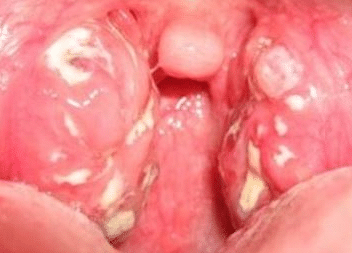
white patches on tonsils
Symptoms usually appears within 2 to 5 days after strep throat infection. The bacteria infection is air borne or can be spread through contact with an infected individual.
- Severe and sudden sore throat without coughing, sneezing, or other cold symptoms.
- Pain or difficulty with swallowing.
- Fever over 101°F (38.3°C). Lower fevers may point to a viral infection and not strep.
- Swollen lymph nodes in the neck.
- White or yellow spots or coating on the throat and tonsils.
- Skin rah around the neck and eventually the whole body.
- Bright red throat or dark red spots on the roof of the mouth at the back near the throat.
- Swollen tonsils, although this symptom may also be caused by a viral infection.
If strep throat is not properly treated using antibiotics, it can become contagious and spread to other parts of the body. Sinus infection, rheumatic fever and weak immune system are some of the complications and may require urgent medical attention.
When to Call a Doctor
- No improvement after taking antibiotic for 24 to 48 hours.
- Sore throat accompanied by tender swollen lymph glands.
- A red rash that feels like sandpaper. This may indicate scarlet fever.
- Difficulty sleeping because your throat is blocked by swollen tonsils or adenoids.
- Weakness and joint pain
- Shortness of breath
- Raised red rash or lumps under the skin
- Uncontrolled, jerking movements of the arms or legs
How to Treat Strep Throat – cure
Antibiotics are the best medication for the treatment of bacterial infections. Viral and allergies infection are not treated using this type of treatment. Some of the best antibiotics include; amoxicillin, cephalexin and penicillin. Immediately after rapid strep test, antibiotic should begin.
Antibiotic kill the bacteria and reduces the time a patient is contagious within 24 hours of taking. It also prevent the occurrence of rare complications of strep such ad ear infection, sinus infections, rheumatic fever and weak immune system. They also relieve pain discomfort and enhance faster healing process.
Other nonprescription medicines such as Acetaminophen can be used to relieve the pain, ease discomfort in the throat and reduce fever. There are also things you can do in the meantime before treatments which will also help in preventing rapid infection and symptoms.
How to Manage Strep Throat at Home – From Spreading
- Keep your hands clean always and cover your mouth while sneezing.
- Gargling with salt warm water may help remove the white spots on tonsils and ease pain and discomfort.
- Rest, take fluids and soft foods and pain killers such ad ibuprofen or acetaminophen.
- Stay away from irritants such ad cigarette smoke which may increase chances of other infections.
- Drink plenty of water to keep your throat moisturized and lubricated to ease swallowing and prevent dehydration.
- Use a humidifier to unclog the blocked airways due to inflammation of tissues.
- Avoid sharing of personal items with other since this can lead to more spreading.
How to Prevent Strep Throat
Here are ways on how to avoid getting infected with bacterial that causes strep.
- Always avoid contact with anyone who has strep infection.
- Wash your hand with antibacterial soap when you are around infected people.
- Do not share personal items such as toothbrushes, eating or drinking utensils.
- Ensure you have a balanced diet that helps your body to stay resistant from bacterial infections.
- Avoid stress and learn how to manage it since it negatively impact on your immune system.
- Humidify your home especially during winter as this helps to keep mucous membranes hydrated.
- Avoid smoking and keep away from other irritants that may trigger throat infections.
Oral Thrush
This is a fungal infection of the mouth. It is also called oral candidiasis and it is mainly caused by yeasts called candida which naturally found in the mouth in low numbers and digestive system. This condition causes white spots on tonsils and may also associate other symptoms.
Symptoms of Oral Thrush
- White patches (plaques) in the mouth that can often be wiped off, leaving behind red areas that may bleed slightly.
- Loss of taste or an unpleasant taste in the mouth.
- Redness inside the mouth and throat.
- Cracks at the corners of the mouth.
- A painful, burning sensation in the mouth.
- Creamy white lesions on your tongue, inner cheeks, and sometimes on the roof of your mouth, gums and tonsils.
- Slightly raised lesions with a cottage cheese-like appearance.
- Redness or soreness that may be severe enough to cause difficulty eating or swallowing.
- Slight bleeding if the lesions are rubbed or scraped.
- Cracking and redness at the corners of your mouth.
- A cottony feeling in your mouth
Main Causes of Oral Thrush
Candida yeast are the main causes of this condition especially when they multiply. In low numbers they never associate any problems but there are some factors that can make them to multiply and cause oral thrush and they include the following:
- Taking a course of antibiotics, particularly over a long period or at a high dose.
- Taking inhaled corticosteroid medication for asthma.
- Wearing dentures (false teeth), particularly if they don’t fit properly.
- Having poor oral hygiene.
- Having a dry mouth, either because of a medical condition or a medication you are taking.
- Smoking and contact with other irritants.
- Having chemotherapy or radiotherapy to treat cancer.
People with underlying medical conditions such as diabetes, underactive thyroid, HIV, STD, iron deficiency or vitamin B12 are at high risk. Infants, young children and elderly individuals are at high risk of developing oral thrush.
How to Treat Oral Thrush
Antifungal medication are the nest for the treatment of this mouth condition. Diagnosis by the doctor can help in the establishment of the real causes of white patches on throat and hence suitable medication.
Tropical medications such as gels and creams, tablets and capsules are given under prescription for the treatment of oral thrush. Most of medication given may have side effects such ad nausea, bloating, vomiting and abdominal pain.
Antibiotics or corticosteroids which are thought to cause oral thrush should be changed or reduced in doge other than also changing the mode of administration. Seeking medical advice is highly recommended since it enables your GP to diagnose and treat the condition and it helps in preventing the spreading to others.
How to Prevent Oral Thrush
You can do the following to prevent sprout and multiplication of yeast in your mouth:
- Rinse your mouth after every meal.
- Fluoride toothpaste should be used to brush your teeth at least twice a day.
- Always visit your dentist regardless of having natural teeth or dentures.
- Remove dentures every night and wash them thoroughly with soap.
- Clean your mouth gums, and tongue using a brush on daily basis.
- Check if you have any underlying medical condition.
Mononucleosis (mono)
This is also called kissing disease and it is a viral infection easily transmitted through kissing. You can also get infected with mono though exposure to cough, sneeze or through sharing of personal items with someone.
Symptoms of Mononucleosis
Fever and sore throat are main signs although they disappear within a couple of weeks. Mono virus usually has an incubation period of 4 to 6 week but may be shorter in infants and young children. Long lasting signs include fatigue, enlarged lymph nodes and swollen spleen. Here are common symptoms of mono:
- Fatigue
- Sore throat.
- Fever
- Swollen lymph nodes in your neck and armpits
- Swollen tonsils
- Headache
- Skin rash
- White patches on tonsils
- Soft, swollen spleen
The doctor has to examine the patient and make report based on symptoms. Blood test of that involve antibody test and white blood cell count will give a doctor a clear knowledge on the presence of mononucleosis.
How to Treat Mononucleosis
This is a viral infection and there is no specific therapy for its treatment. Normally antibiotics doesn’t help in viral infections. A patient is however advised to embark on principles that will establish and boost the immune system to fight the mono viral infection.
There is high possibility of secondary infections such as strep, sinus infection which may require treatment using antibiotics. There is possibility of rash development among some mono infected individuals who are using other medications such as amoxicillin and other penicillin derivatives.
Corticosteroid medications such as prednisone may be given by the doctor to ease associated symptoms such as swelling of the tonsils and pain in the throat. Home remedies may help in the pain management. Drinking plenty of water and fluids is recommended. Gargle with sea salt water to relieve discomfort. Over the counter painkillers such ad acetaminophen or ibuprofen may be important.
Leukoplakia
This is a condition characterized by white spots in the mouth and on the throat. Smoking and chewing tobacco are the biggest risk factors for this condition.
Treatment
Stopping the use of any tobacco products and alcohol, makes the condition to end on its own. Portions of larger patches can be removed by a scalpel or laser treatment. If cancer is suspected, a cold probe is used to freeze cells and remove for testing.
Treatments for White Spots on Tonsils
General treatments ranges from the use of home remedies to medical techniques.
Home remedies
These includes lifestyle and use of natural ingredients.
- Rest well and avoid movements as this will also prevent you from infecting others.
- Drink plenty of water to reduce fever, stay hydrated and fight the infection faster.
- Gargle with salty warm water. Salt has antiviral, antifungal and antibacterial properties.
- Avoid certain foods like hot and spicy foods, chips, raw vegetables, foods that contain high acids like tomato sauce as they will aggravate the pain by irritating the throat.
- Avoid smoking as the smoke may worsen that condition and also increase risk of having complications.
- Relieve your painful throat by taking un-prescribed painkillers like ibuprofen.
- Humidify the air as dry air tends to irritate your throat.
- Take a well-balanced diet to improve in your immune system.
Medical Treatments
These ranges from over the counter prescriptions and nonprescription medicines for tonsils to surgery for the treatment of chronic cases. The medicines may be used as antibiotics or pain killers. Viral infections are mainly tackled by the immune system itself.
Medications for tonsils
- Penicillin (Permapen, Benzathine)
- Rifampin (Rifadin, Lyphocin)
- Amoxicillin (Biomox, Trinmox, Amoxil)
- Ketoprofen (Orudis)
- Naproxn (Naprosyn, Anaprox)
- Ibuprofen (Motrin)
Surgery to remove tonsils is only ideal as the last option since tonsils are very important part of immune system.
Therefore treatment of white spots on tonsils depends mainly on the respective causes since it is a condition that can be caused by different types of infections ranging from yeasts, bacteria to viral.
More sources and references
- Tonsil Stones: Symptoms, Treatment and More: http://www.healthline.com/health/dental-and-oral-health/tonsil-stones#1
- Tonsillitis: Symptoms, Causes, and Treatments: http://www.webmd.com/oral-health/guide/tonsillitis-symptoms-causes-and-treatments
- Strep throat: http://www.mayoclinic.org/diseases-conditions/strep-throat/basics/symptoms/con-20022811
- Oral thrush in adults: http://www.nhs.uk/Conditions/Oral-thrush—adults/Pages/Introduction.aspx
- Thrush (Oral Candidiasis): http://www.medicinenet.com/thrush/article.htm
- Mononucleosis: http://www.emedicinehealth.com/mononucleosis/page3_em.htm




